University Accounting Assignment: Current Developments Analysis
VerifiedAdded on 2020/03/28
|12
|3628
|355
Homework Assignment
AI Summary
This assignment, completed by a student, analyzes two key developments in the accounting field. The first part examines a news article concerning the KPMG audit firm, focusing on integrity issues related to leaked information about PCAOB inspections. The analysis delves into the firm's deficiencies, the role of the PCAOB, and the need for improved audit quality and stricter regulations to maintain public trust and financial market integrity. The second part of the assignment focuses on the new Exposure Draft (ED) on IAS 8, addressing changes in accounting policies and estimates. It highlights the importance of distinguishing between accounting estimates and policies, clarifying definitions, and the selection of estimation techniques to ensure accurate financial reporting. The assignment emphasizes the significance of these developments for financial statement users and the overall health of the financial markets.

Paraphrase This Document
Need a fresh take? Get an instant paraphrase of this document with our AI Paraphraser

1
By student name
Professor
University
Date: 25 September 2017.
1 | P a g e
By student name
Professor
University
Date: 25 September 2017.
1 | P a g e

2
Contents
Question No. 1....……………………………..……………………………………………………………….3
Question No. 2....……………………………..……………………………………………………………….6
Refrences.....……………………………………………………………….......................................10
2 | P a g e
Contents
Question No. 1....……………………………..……………………………………………………………….3
Question No. 2....……………………………..……………………………………………………………….6
Refrences.....……………………………………………………………….......................................10
2 | P a g e
⊘ This is a preview!⊘
Do you want full access?
Subscribe today to unlock all pages.

Trusted by 1+ million students worldwide
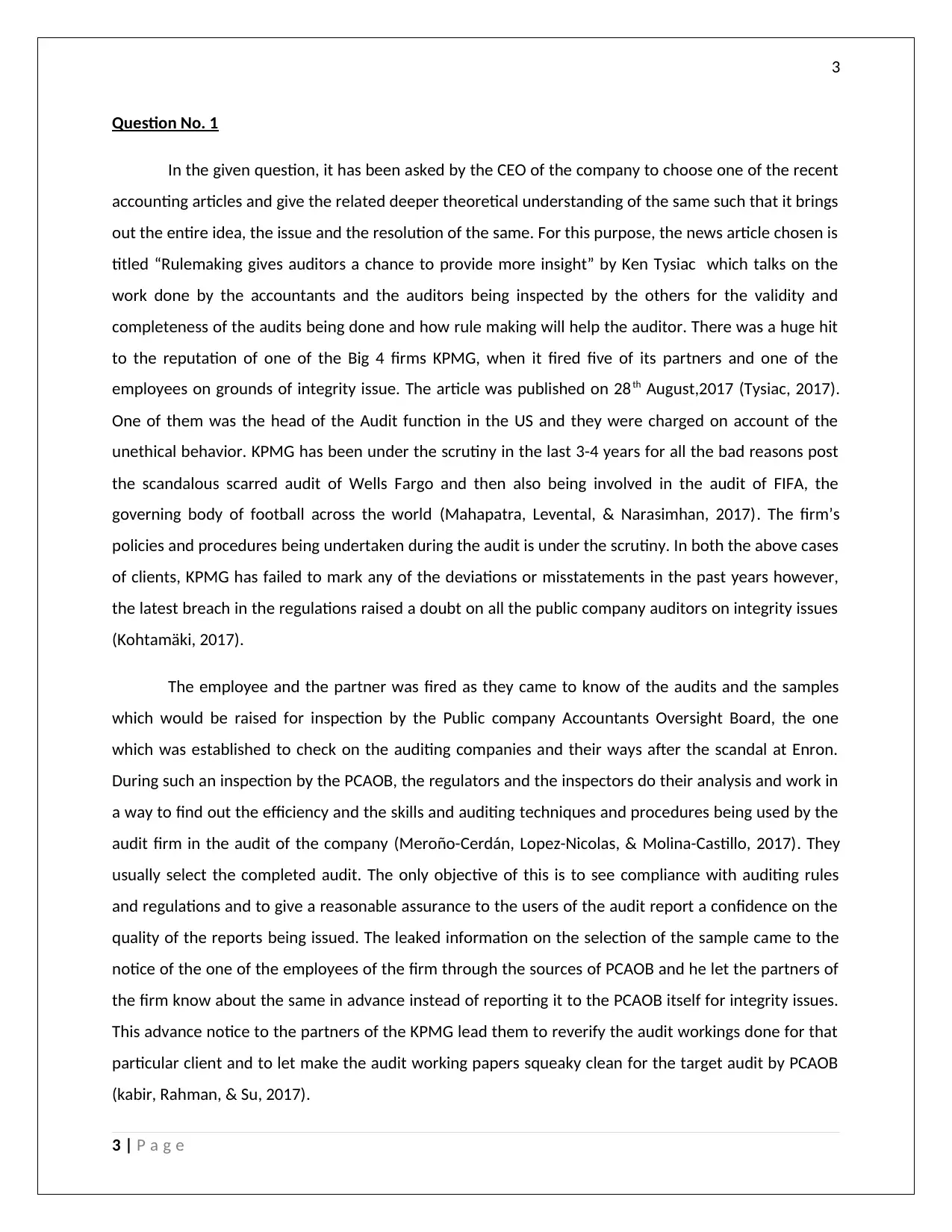
3
Question No. 1
In the given question, it has been asked by the CEO of the company to choose one of the recent
accounting articles and give the related deeper theoretical understanding of the same such that it brings
out the entire idea, the issue and the resolution of the same. For this purpose, the news article chosen is
titled “Rulemaking gives auditors a chance to provide more insight” by Ken Tysiac which talks on the
work done by the accountants and the auditors being inspected by the others for the validity and
completeness of the audits being done and how rule making will help the auditor. There was a huge hit
to the reputation of one of the Big 4 firms KPMG, when it fired five of its partners and one of the
employees on grounds of integrity issue. The article was published on 28th August,2017 (Tysiac, 2017).
One of them was the head of the Audit function in the US and they were charged on account of the
unethical behavior. KPMG has been under the scrutiny in the last 3-4 years for all the bad reasons post
the scandalous scarred audit of Wells Fargo and then also being involved in the audit of FIFA, the
governing body of football across the world (Mahapatra, Levental, & Narasimhan, 2017). The firm’s
policies and procedures being undertaken during the audit is under the scrutiny. In both the above cases
of clients, KPMG has failed to mark any of the deviations or misstatements in the past years however,
the latest breach in the regulations raised a doubt on all the public company auditors on integrity issues
(Kohtamäki, 2017).
The employee and the partner was fired as they came to know of the audits and the samples
which would be raised for inspection by the Public company Accountants Oversight Board, the one
which was established to check on the auditing companies and their ways after the scandal at Enron.
During such an inspection by the PCAOB, the regulators and the inspectors do their analysis and work in
a way to find out the efficiency and the skills and auditing techniques and procedures being used by the
audit firm in the audit of the company (Meroño-Cerdán, Lopez-Nicolas, & Molina-Castillo, 2017). They
usually select the completed audit. The only objective of this is to see compliance with auditing rules
and regulations and to give a reasonable assurance to the users of the audit report a confidence on the
quality of the reports being issued. The leaked information on the selection of the sample came to the
notice of the one of the employees of the firm through the sources of PCAOB and he let the partners of
the firm know about the same in advance instead of reporting it to the PCAOB itself for integrity issues.
This advance notice to the partners of the KPMG lead them to reverify the audit workings done for that
particular client and to let make the audit working papers squeaky clean for the target audit by PCAOB
(kabir, Rahman, & Su, 2017).
3 | P a g e
Question No. 1
In the given question, it has been asked by the CEO of the company to choose one of the recent
accounting articles and give the related deeper theoretical understanding of the same such that it brings
out the entire idea, the issue and the resolution of the same. For this purpose, the news article chosen is
titled “Rulemaking gives auditors a chance to provide more insight” by Ken Tysiac which talks on the
work done by the accountants and the auditors being inspected by the others for the validity and
completeness of the audits being done and how rule making will help the auditor. There was a huge hit
to the reputation of one of the Big 4 firms KPMG, when it fired five of its partners and one of the
employees on grounds of integrity issue. The article was published on 28th August,2017 (Tysiac, 2017).
One of them was the head of the Audit function in the US and they were charged on account of the
unethical behavior. KPMG has been under the scrutiny in the last 3-4 years for all the bad reasons post
the scandalous scarred audit of Wells Fargo and then also being involved in the audit of FIFA, the
governing body of football across the world (Mahapatra, Levental, & Narasimhan, 2017). The firm’s
policies and procedures being undertaken during the audit is under the scrutiny. In both the above cases
of clients, KPMG has failed to mark any of the deviations or misstatements in the past years however,
the latest breach in the regulations raised a doubt on all the public company auditors on integrity issues
(Kohtamäki, 2017).
The employee and the partner was fired as they came to know of the audits and the samples
which would be raised for inspection by the Public company Accountants Oversight Board, the one
which was established to check on the auditing companies and their ways after the scandal at Enron.
During such an inspection by the PCAOB, the regulators and the inspectors do their analysis and work in
a way to find out the efficiency and the skills and auditing techniques and procedures being used by the
audit firm in the audit of the company (Meroño-Cerdán, Lopez-Nicolas, & Molina-Castillo, 2017). They
usually select the completed audit. The only objective of this is to see compliance with auditing rules
and regulations and to give a reasonable assurance to the users of the audit report a confidence on the
quality of the reports being issued. The leaked information on the selection of the sample came to the
notice of the one of the employees of the firm through the sources of PCAOB and he let the partners of
the firm know about the same in advance instead of reporting it to the PCAOB itself for integrity issues.
This advance notice to the partners of the KPMG lead them to reverify the audit workings done for that
particular client and to let make the audit working papers squeaky clean for the target audit by PCAOB
(kabir, Rahman, & Su, 2017).
3 | P a g e
Paraphrase This Document
Need a fresh take? Get an instant paraphrase of this document with our AI Paraphraser
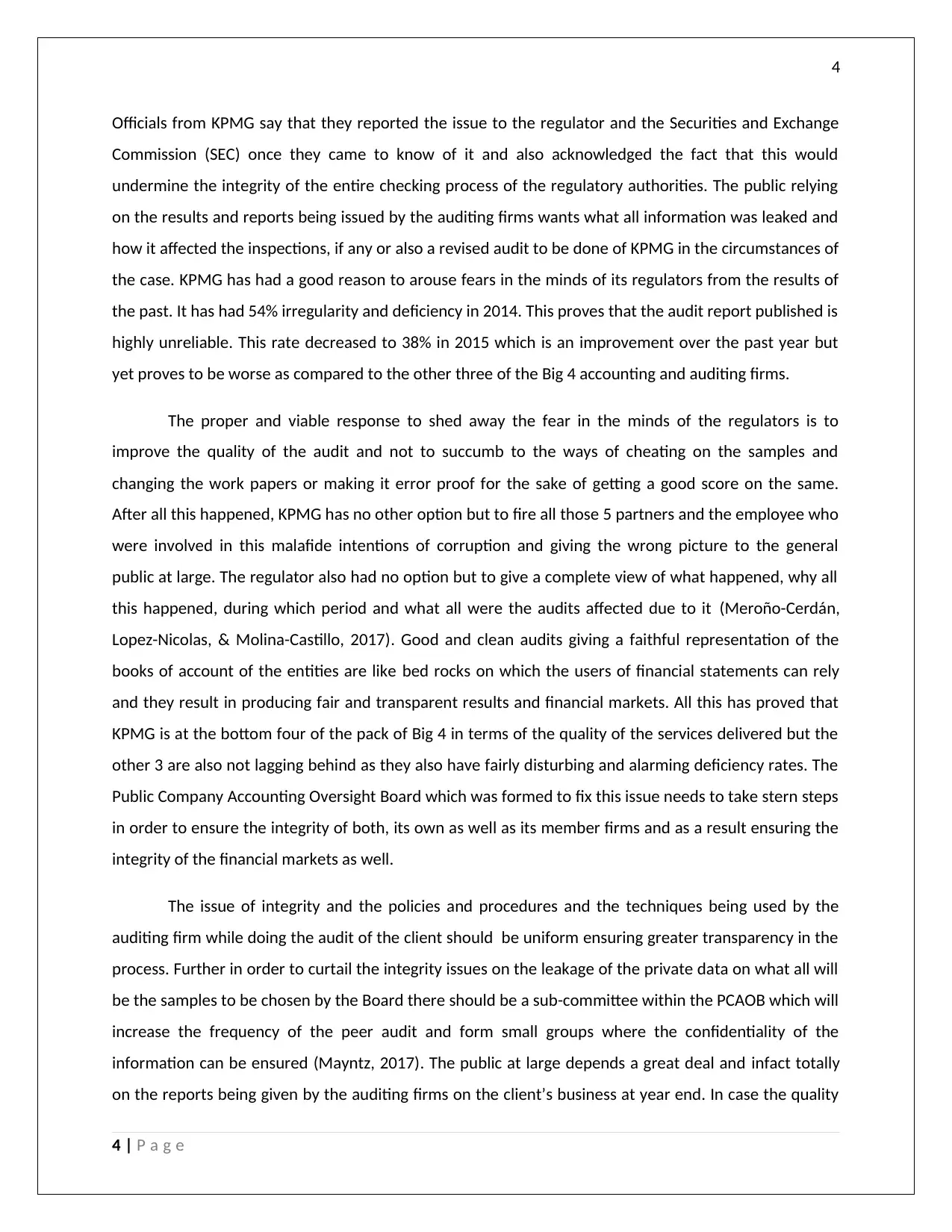
4
Officials from KPMG say that they reported the issue to the regulator and the Securities and Exchange
Commission (SEC) once they came to know of it and also acknowledged the fact that this would
undermine the integrity of the entire checking process of the regulatory authorities. The public relying
on the results and reports being issued by the auditing firms wants what all information was leaked and
how it affected the inspections, if any or also a revised audit to be done of KPMG in the circumstances of
the case. KPMG has had a good reason to arouse fears in the minds of its regulators from the results of
the past. It has had 54% irregularity and deficiency in 2014. This proves that the audit report published is
highly unreliable. This rate decreased to 38% in 2015 which is an improvement over the past year but
yet proves to be worse as compared to the other three of the Big 4 accounting and auditing firms.
The proper and viable response to shed away the fear in the minds of the regulators is to
improve the quality of the audit and not to succumb to the ways of cheating on the samples and
changing the work papers or making it error proof for the sake of getting a good score on the same.
After all this happened, KPMG has no other option but to fire all those 5 partners and the employee who
were involved in this malafide intentions of corruption and giving the wrong picture to the general
public at large. The regulator also had no option but to give a complete view of what happened, why all
this happened, during which period and what all were the audits affected due to it (Meroño-Cerdán,
Lopez-Nicolas, & Molina-Castillo, 2017). Good and clean audits giving a faithful representation of the
books of account of the entities are like bed rocks on which the users of financial statements can rely
and they result in producing fair and transparent results and financial markets. All this has proved that
KPMG is at the bottom four of the pack of Big 4 in terms of the quality of the services delivered but the
other 3 are also not lagging behind as they also have fairly disturbing and alarming deficiency rates. The
Public Company Accounting Oversight Board which was formed to fix this issue needs to take stern steps
in order to ensure the integrity of both, its own as well as its member firms and as a result ensuring the
integrity of the financial markets as well.
The issue of integrity and the policies and procedures and the techniques being used by the
auditing firm while doing the audit of the client should be uniform ensuring greater transparency in the
process. Further in order to curtail the integrity issues on the leakage of the private data on what all will
be the samples to be chosen by the Board there should be a sub-committee within the PCAOB which will
increase the frequency of the peer audit and form small groups where the confidentiality of the
information can be ensured (Mayntz, 2017). The public at large depends a great deal and infact totally
on the reports being given by the auditing firms on the client’s business at year end. In case the quality
4 | P a g e
Officials from KPMG say that they reported the issue to the regulator and the Securities and Exchange
Commission (SEC) once they came to know of it and also acknowledged the fact that this would
undermine the integrity of the entire checking process of the regulatory authorities. The public relying
on the results and reports being issued by the auditing firms wants what all information was leaked and
how it affected the inspections, if any or also a revised audit to be done of KPMG in the circumstances of
the case. KPMG has had a good reason to arouse fears in the minds of its regulators from the results of
the past. It has had 54% irregularity and deficiency in 2014. This proves that the audit report published is
highly unreliable. This rate decreased to 38% in 2015 which is an improvement over the past year but
yet proves to be worse as compared to the other three of the Big 4 accounting and auditing firms.
The proper and viable response to shed away the fear in the minds of the regulators is to
improve the quality of the audit and not to succumb to the ways of cheating on the samples and
changing the work papers or making it error proof for the sake of getting a good score on the same.
After all this happened, KPMG has no other option but to fire all those 5 partners and the employee who
were involved in this malafide intentions of corruption and giving the wrong picture to the general
public at large. The regulator also had no option but to give a complete view of what happened, why all
this happened, during which period and what all were the audits affected due to it (Meroño-Cerdán,
Lopez-Nicolas, & Molina-Castillo, 2017). Good and clean audits giving a faithful representation of the
books of account of the entities are like bed rocks on which the users of financial statements can rely
and they result in producing fair and transparent results and financial markets. All this has proved that
KPMG is at the bottom four of the pack of Big 4 in terms of the quality of the services delivered but the
other 3 are also not lagging behind as they also have fairly disturbing and alarming deficiency rates. The
Public Company Accounting Oversight Board which was formed to fix this issue needs to take stern steps
in order to ensure the integrity of both, its own as well as its member firms and as a result ensuring the
integrity of the financial markets as well.
The issue of integrity and the policies and procedures and the techniques being used by the
auditing firm while doing the audit of the client should be uniform ensuring greater transparency in the
process. Further in order to curtail the integrity issues on the leakage of the private data on what all will
be the samples to be chosen by the Board there should be a sub-committee within the PCAOB which will
increase the frequency of the peer audit and form small groups where the confidentiality of the
information can be ensured (Mayntz, 2017). The public at large depends a great deal and infact totally
on the reports being given by the auditing firms on the client’s business at year end. In case the quality
4 | P a g e

5
of the same itself is not upto the mark and contains material misstatements and deficiencies being not
highlighted at the right time, this may result in the wrong picture of the financial markets and the public
will suffer at large when the balloon bursts as we have seen in the past in the case of Enron scandal.
Further more, the auditing firms need to take responsibility of not coming under undue pressure of the
clients and other companies in the wake of old working relationships and audit fees. They should be
crystal clear in their intent and in case of any such integrity issues, must report the same immediately to
the respective accounting bodies, the company’s boards and also the PCAOB such that the corrective
and remedial actions can be taken against such a company (Dowding, 2017). Moreover, not only on the
company, but the issue of integrity relies equally amongst the big 4 audit firms and any such breach
should be punished highly with the ban on the practice of the accountants and auditors who do so. The
PCAOB has to come up with some of the stern steps to ensure that the quality of the audit increases and
deficiency rate can be dropped to single digits and further zero by also putting a restriction on the
number of clientele that can be managed by a single partner and also a limit on the number of audits
being done in a particular year. This will ensure the quality to be increased by the auditing firms.
Further, there should be an action plan and the punishment in terms of fine and banning from audit for
a couple of years in case any person is found guilty of breach of the audit quality and misstatements
being covered even though the same is in notice and evident on the prima facie view (J, 2016).
From the above accounting news which has been under scrutiny in many forms over the last
many years, it can be concluded that the quality of audit needs an immediate upscaling which can not
only be done by doing the audit of the auditing firm by the Public Company Accounting Oversight Board
but bringing in new measures which will tighten the screws and the regulatory needs. Moreover, it is the
big 4 accountants and auditors who need to understand the long term impact of all the reports they
publish on the financial markets, the decision of the investors and the future of the companies. There
have been many dummy companies which are still thriving in the system only because of the support
being lent by the auditing firms who need to expose them through the financial statement and audit
opinion so that the respectability and integrity in the profession as well as the faith on the accountants
by the general public can be restored (Goldmann, 2016).
5 | P a g e
of the same itself is not upto the mark and contains material misstatements and deficiencies being not
highlighted at the right time, this may result in the wrong picture of the financial markets and the public
will suffer at large when the balloon bursts as we have seen in the past in the case of Enron scandal.
Further more, the auditing firms need to take responsibility of not coming under undue pressure of the
clients and other companies in the wake of old working relationships and audit fees. They should be
crystal clear in their intent and in case of any such integrity issues, must report the same immediately to
the respective accounting bodies, the company’s boards and also the PCAOB such that the corrective
and remedial actions can be taken against such a company (Dowding, 2017). Moreover, not only on the
company, but the issue of integrity relies equally amongst the big 4 audit firms and any such breach
should be punished highly with the ban on the practice of the accountants and auditors who do so. The
PCAOB has to come up with some of the stern steps to ensure that the quality of the audit increases and
deficiency rate can be dropped to single digits and further zero by also putting a restriction on the
number of clientele that can be managed by a single partner and also a limit on the number of audits
being done in a particular year. This will ensure the quality to be increased by the auditing firms.
Further, there should be an action plan and the punishment in terms of fine and banning from audit for
a couple of years in case any person is found guilty of breach of the audit quality and misstatements
being covered even though the same is in notice and evident on the prima facie view (J, 2016).
From the above accounting news which has been under scrutiny in many forms over the last
many years, it can be concluded that the quality of audit needs an immediate upscaling which can not
only be done by doing the audit of the auditing firm by the Public Company Accounting Oversight Board
but bringing in new measures which will tighten the screws and the regulatory needs. Moreover, it is the
big 4 accountants and auditors who need to understand the long term impact of all the reports they
publish on the financial markets, the decision of the investors and the future of the companies. There
have been many dummy companies which are still thriving in the system only because of the support
being lent by the auditing firms who need to expose them through the financial statement and audit
opinion so that the respectability and integrity in the profession as well as the faith on the accountants
by the general public can be restored (Goldmann, 2016).
5 | P a g e
⊘ This is a preview!⊘
Do you want full access?
Subscribe today to unlock all pages.

Trusted by 1+ million students worldwide
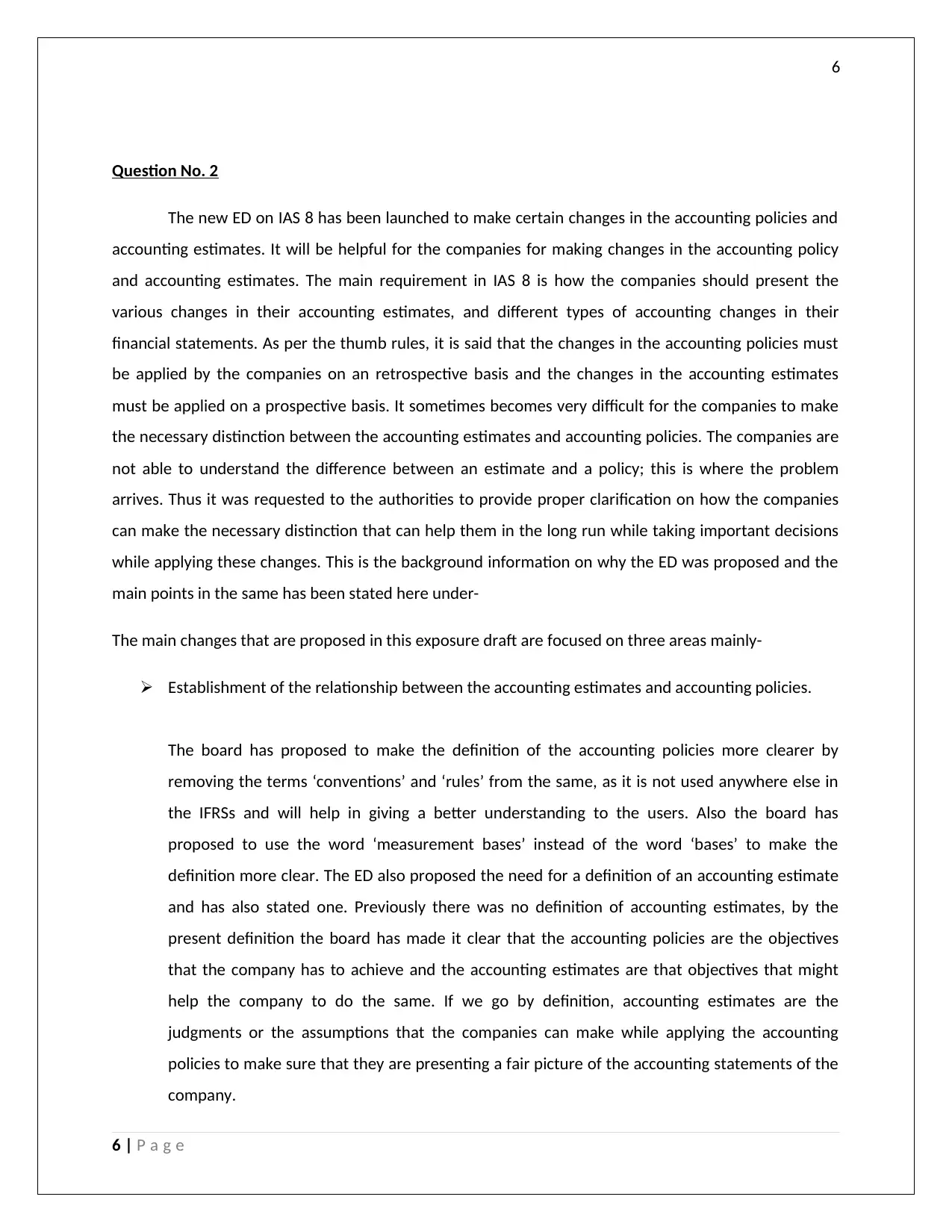
6
Question No. 2
The new ED on IAS 8 has been launched to make certain changes in the accounting policies and
accounting estimates. It will be helpful for the companies for making changes in the accounting policy
and accounting estimates. The main requirement in IAS 8 is how the companies should present the
various changes in their accounting estimates, and different types of accounting changes in their
financial statements. As per the thumb rules, it is said that the changes in the accounting policies must
be applied by the companies on an retrospective basis and the changes in the accounting estimates
must be applied on a prospective basis. It sometimes becomes very difficult for the companies to make
the necessary distinction between the accounting estimates and accounting policies. The companies are
not able to understand the difference between an estimate and a policy; this is where the problem
arrives. Thus it was requested to the authorities to provide proper clarification on how the companies
can make the necessary distinction that can help them in the long run while taking important decisions
while applying these changes. This is the background information on why the ED was proposed and the
main points in the same has been stated here under-
The main changes that are proposed in this exposure draft are focused on three areas mainly-
Establishment of the relationship between the accounting estimates and accounting policies.
The board has proposed to make the definition of the accounting policies more clearer by
removing the terms ‘conventions’ and ‘rules’ from the same, as it is not used anywhere else in
the IFRSs and will help in giving a better understanding to the users. Also the board has
proposed to use the word ‘measurement bases’ instead of the word ‘bases’ to make the
definition more clear. The ED also proposed the need for a definition of an accounting estimate
and has also stated one. Previously there was no definition of accounting estimates, by the
present definition the board has made it clear that the accounting policies are the objectives
that the company has to achieve and the accounting estimates are that objectives that might
help the company to do the same. If we go by definition, accounting estimates are the
judgments or the assumptions that the companies can make while applying the accounting
policies to make sure that they are presenting a fair picture of the accounting statements of the
company.
6 | P a g e
Question No. 2
The new ED on IAS 8 has been launched to make certain changes in the accounting policies and
accounting estimates. It will be helpful for the companies for making changes in the accounting policy
and accounting estimates. The main requirement in IAS 8 is how the companies should present the
various changes in their accounting estimates, and different types of accounting changes in their
financial statements. As per the thumb rules, it is said that the changes in the accounting policies must
be applied by the companies on an retrospective basis and the changes in the accounting estimates
must be applied on a prospective basis. It sometimes becomes very difficult for the companies to make
the necessary distinction between the accounting estimates and accounting policies. The companies are
not able to understand the difference between an estimate and a policy; this is where the problem
arrives. Thus it was requested to the authorities to provide proper clarification on how the companies
can make the necessary distinction that can help them in the long run while taking important decisions
while applying these changes. This is the background information on why the ED was proposed and the
main points in the same has been stated here under-
The main changes that are proposed in this exposure draft are focused on three areas mainly-
Establishment of the relationship between the accounting estimates and accounting policies.
The board has proposed to make the definition of the accounting policies more clearer by
removing the terms ‘conventions’ and ‘rules’ from the same, as it is not used anywhere else in
the IFRSs and will help in giving a better understanding to the users. Also the board has
proposed to use the word ‘measurement bases’ instead of the word ‘bases’ to make the
definition more clear. The ED also proposed the need for a definition of an accounting estimate
and has also stated one. Previously there was no definition of accounting estimates, by the
present definition the board has made it clear that the accounting policies are the objectives
that the company has to achieve and the accounting estimates are that objectives that might
help the company to do the same. If we go by definition, accounting estimates are the
judgments or the assumptions that the companies can make while applying the accounting
policies to make sure that they are presenting a fair picture of the accounting statements of the
company.
6 | P a g e
Paraphrase This Document
Need a fresh take? Get an instant paraphrase of this document with our AI Paraphraser
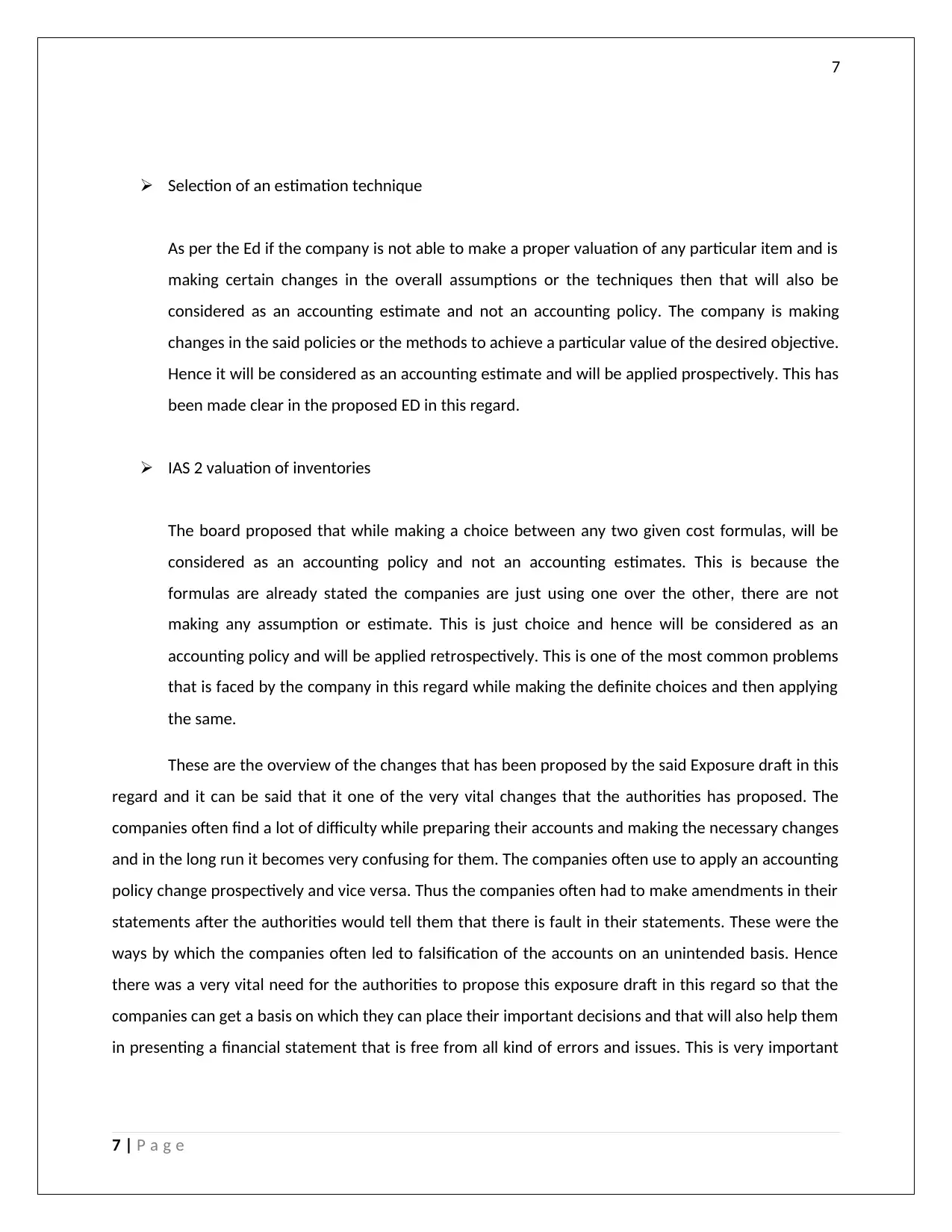
7
Selection of an estimation technique
As per the Ed if the company is not able to make a proper valuation of any particular item and is
making certain changes in the overall assumptions or the techniques then that will also be
considered as an accounting estimate and not an accounting policy. The company is making
changes in the said policies or the methods to achieve a particular value of the desired objective.
Hence it will be considered as an accounting estimate and will be applied prospectively. This has
been made clear in the proposed ED in this regard.
IAS 2 valuation of inventories
The board proposed that while making a choice between any two given cost formulas, will be
considered as an accounting policy and not an accounting estimates. This is because the
formulas are already stated the companies are just using one over the other, there are not
making any assumption or estimate. This is just choice and hence will be considered as an
accounting policy and will be applied retrospectively. This is one of the most common problems
that is faced by the company in this regard while making the definite choices and then applying
the same.
These are the overview of the changes that has been proposed by the said Exposure draft in this
regard and it can be said that it one of the very vital changes that the authorities has proposed. The
companies often find a lot of difficulty while preparing their accounts and making the necessary changes
and in the long run it becomes very confusing for them. The companies often use to apply an accounting
policy change prospectively and vice versa. Thus the companies often had to make amendments in their
statements after the authorities would tell them that there is fault in their statements. These were the
ways by which the companies often led to falsification of the accounts on an unintended basis. Hence
there was a very vital need for the authorities to propose this exposure draft in this regard so that the
companies can get a basis on which they can place their important decisions and that will also help them
in presenting a financial statement that is free from all kind of errors and issues. This is very important
7 | P a g e
Selection of an estimation technique
As per the Ed if the company is not able to make a proper valuation of any particular item and is
making certain changes in the overall assumptions or the techniques then that will also be
considered as an accounting estimate and not an accounting policy. The company is making
changes in the said policies or the methods to achieve a particular value of the desired objective.
Hence it will be considered as an accounting estimate and will be applied prospectively. This has
been made clear in the proposed ED in this regard.
IAS 2 valuation of inventories
The board proposed that while making a choice between any two given cost formulas, will be
considered as an accounting policy and not an accounting estimates. This is because the
formulas are already stated the companies are just using one over the other, there are not
making any assumption or estimate. This is just choice and hence will be considered as an
accounting policy and will be applied retrospectively. This is one of the most common problems
that is faced by the company in this regard while making the definite choices and then applying
the same.
These are the overview of the changes that has been proposed by the said Exposure draft in this
regard and it can be said that it one of the very vital changes that the authorities has proposed. The
companies often find a lot of difficulty while preparing their accounts and making the necessary changes
and in the long run it becomes very confusing for them. The companies often use to apply an accounting
policy change prospectively and vice versa. Thus the companies often had to make amendments in their
statements after the authorities would tell them that there is fault in their statements. These were the
ways by which the companies often led to falsification of the accounts on an unintended basis. Hence
there was a very vital need for the authorities to propose this exposure draft in this regard so that the
companies can get a basis on which they can place their important decisions and that will also help them
in presenting a financial statement that is free from all kind of errors and issues. This is very important
7 | P a g e
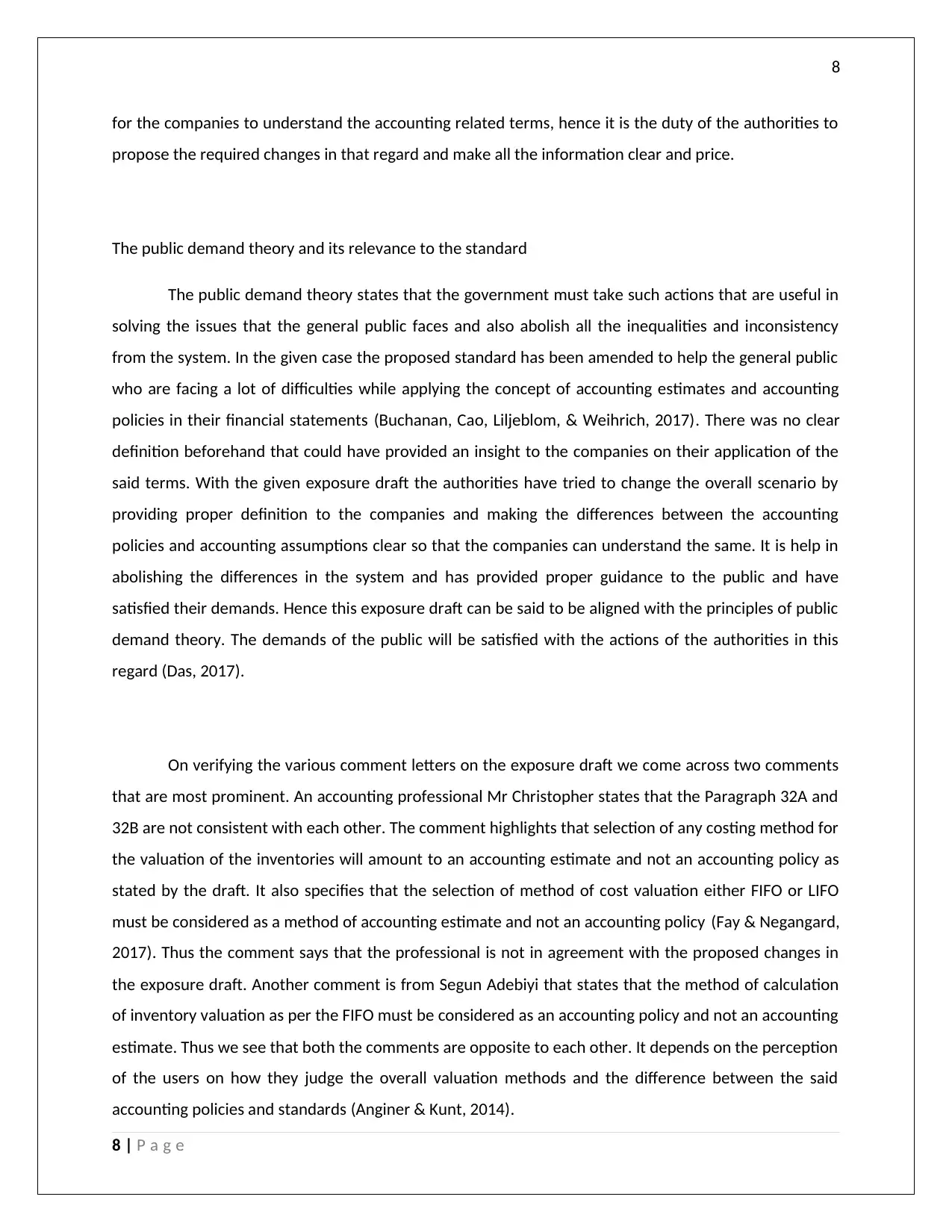
8
for the companies to understand the accounting related terms, hence it is the duty of the authorities to
propose the required changes in that regard and make all the information clear and price.
The public demand theory and its relevance to the standard
The public demand theory states that the government must take such actions that are useful in
solving the issues that the general public faces and also abolish all the inequalities and inconsistency
from the system. In the given case the proposed standard has been amended to help the general public
who are facing a lot of difficulties while applying the concept of accounting estimates and accounting
policies in their financial statements (Buchanan, Cao, Liljeblom, & Weihrich, 2017). There was no clear
definition beforehand that could have provided an insight to the companies on their application of the
said terms. With the given exposure draft the authorities have tried to change the overall scenario by
providing proper definition to the companies and making the differences between the accounting
policies and accounting assumptions clear so that the companies can understand the same. It is help in
abolishing the differences in the system and has provided proper guidance to the public and have
satisfied their demands. Hence this exposure draft can be said to be aligned with the principles of public
demand theory. The demands of the public will be satisfied with the actions of the authorities in this
regard (Das, 2017).
On verifying the various comment letters on the exposure draft we come across two comments
that are most prominent. An accounting professional Mr Christopher states that the Paragraph 32A and
32B are not consistent with each other. The comment highlights that selection of any costing method for
the valuation of the inventories will amount to an accounting estimate and not an accounting policy as
stated by the draft. It also specifies that the selection of method of cost valuation either FIFO or LIFO
must be considered as a method of accounting estimate and not an accounting policy (Fay & Negangard,
2017). Thus the comment says that the professional is not in agreement with the proposed changes in
the exposure draft. Another comment is from Segun Adebiyi that states that the method of calculation
of inventory valuation as per the FIFO must be considered as an accounting policy and not an accounting
estimate. Thus we see that both the comments are opposite to each other. It depends on the perception
of the users on how they judge the overall valuation methods and the difference between the said
accounting policies and standards (Anginer & Kunt, 2014).
8 | P a g e
for the companies to understand the accounting related terms, hence it is the duty of the authorities to
propose the required changes in that regard and make all the information clear and price.
The public demand theory and its relevance to the standard
The public demand theory states that the government must take such actions that are useful in
solving the issues that the general public faces and also abolish all the inequalities and inconsistency
from the system. In the given case the proposed standard has been amended to help the general public
who are facing a lot of difficulties while applying the concept of accounting estimates and accounting
policies in their financial statements (Buchanan, Cao, Liljeblom, & Weihrich, 2017). There was no clear
definition beforehand that could have provided an insight to the companies on their application of the
said terms. With the given exposure draft the authorities have tried to change the overall scenario by
providing proper definition to the companies and making the differences between the accounting
policies and accounting assumptions clear so that the companies can understand the same. It is help in
abolishing the differences in the system and has provided proper guidance to the public and have
satisfied their demands. Hence this exposure draft can be said to be aligned with the principles of public
demand theory. The demands of the public will be satisfied with the actions of the authorities in this
regard (Das, 2017).
On verifying the various comment letters on the exposure draft we come across two comments
that are most prominent. An accounting professional Mr Christopher states that the Paragraph 32A and
32B are not consistent with each other. The comment highlights that selection of any costing method for
the valuation of the inventories will amount to an accounting estimate and not an accounting policy as
stated by the draft. It also specifies that the selection of method of cost valuation either FIFO or LIFO
must be considered as a method of accounting estimate and not an accounting policy (Fay & Negangard,
2017). Thus the comment says that the professional is not in agreement with the proposed changes in
the exposure draft. Another comment is from Segun Adebiyi that states that the method of calculation
of inventory valuation as per the FIFO must be considered as an accounting policy and not an accounting
estimate. Thus we see that both the comments are opposite to each other. It depends on the perception
of the users on how they judge the overall valuation methods and the difference between the said
accounting policies and standards (Anginer & Kunt, 2014).
8 | P a g e
⊘ This is a preview!⊘
Do you want full access?
Subscribe today to unlock all pages.

Trusted by 1+ million students worldwide
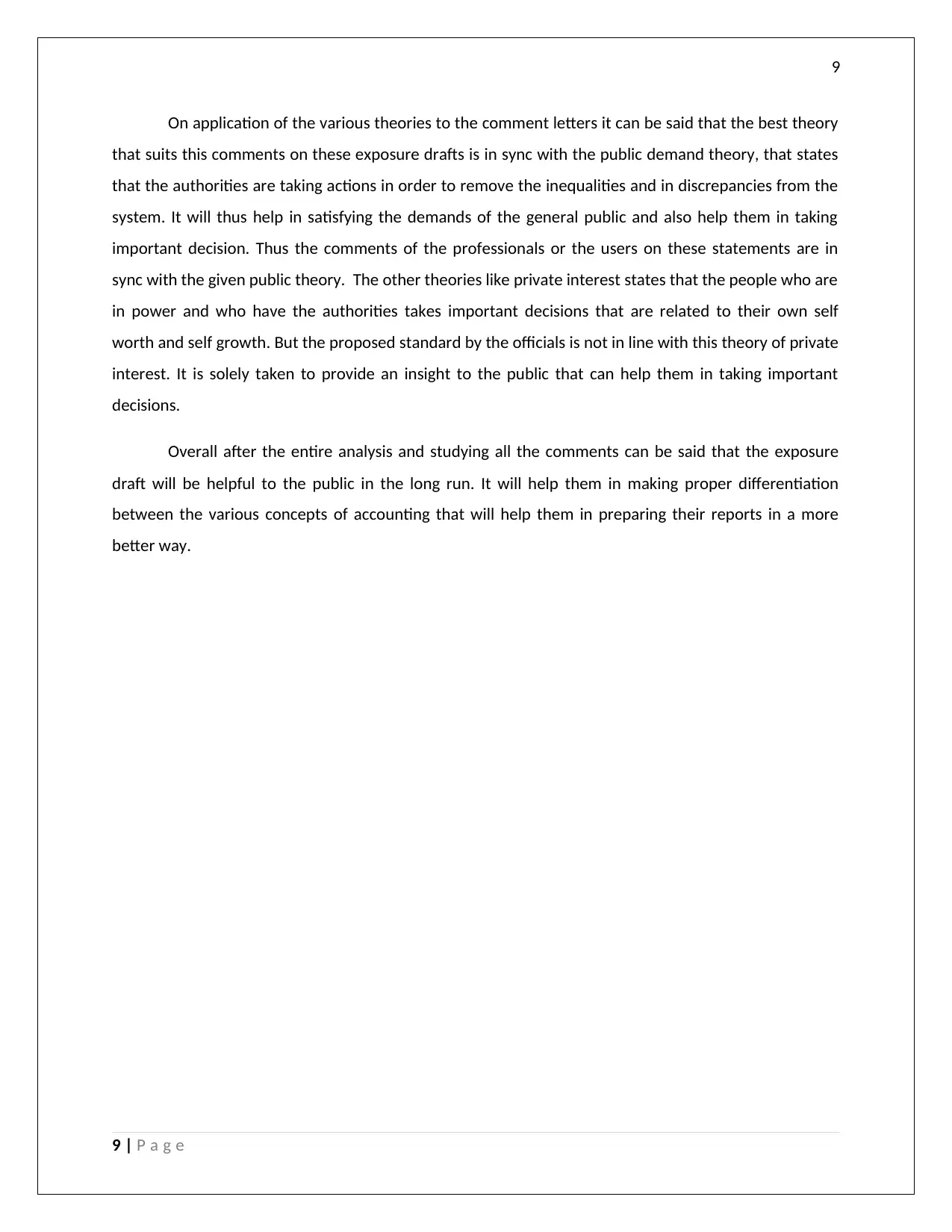
9
On application of the various theories to the comment letters it can be said that the best theory
that suits this comments on these exposure drafts is in sync with the public demand theory, that states
that the authorities are taking actions in order to remove the inequalities and in discrepancies from the
system. It will thus help in satisfying the demands of the general public and also help them in taking
important decision. Thus the comments of the professionals or the users on these statements are in
sync with the given public theory. The other theories like private interest states that the people who are
in power and who have the authorities takes important decisions that are related to their own self
worth and self growth. But the proposed standard by the officials is not in line with this theory of private
interest. It is solely taken to provide an insight to the public that can help them in taking important
decisions.
Overall after the entire analysis and studying all the comments can be said that the exposure
draft will be helpful to the public in the long run. It will help them in making proper differentiation
between the various concepts of accounting that will help them in preparing their reports in a more
better way.
9 | P a g e
On application of the various theories to the comment letters it can be said that the best theory
that suits this comments on these exposure drafts is in sync with the public demand theory, that states
that the authorities are taking actions in order to remove the inequalities and in discrepancies from the
system. It will thus help in satisfying the demands of the general public and also help them in taking
important decision. Thus the comments of the professionals or the users on these statements are in
sync with the given public theory. The other theories like private interest states that the people who are
in power and who have the authorities takes important decisions that are related to their own self
worth and self growth. But the proposed standard by the officials is not in line with this theory of private
interest. It is solely taken to provide an insight to the public that can help them in taking important
decisions.
Overall after the entire analysis and studying all the comments can be said that the exposure
draft will be helpful to the public in the long run. It will help them in making proper differentiation
between the various concepts of accounting that will help them in preparing their reports in a more
better way.
9 | P a g e
Paraphrase This Document
Need a fresh take? Get an instant paraphrase of this document with our AI Paraphraser

10
Refrences
Anginer, D., & Kunt, A. (2014). Has the global banking system become more fragile over time? Journal of
Financial Stability, 13, 202-213.
Buchanan, B., Cao, C., Liljeblom, E., & Weihrich, S. (2017). Taxation and Dividend Policy: The Muting
Effect of Agency Issues and Shareholder Conflicts. Journal of Corporate Finance, 42, 179-197.
Das, P. (2017). Financing Pattern and Utilization of Fixed Assets - A Study. Asian Journal of Social Science
Studies, 2(2), 10-17.
Dowding, K. (2017). Australian exceptionalism reconsidered. Australian journal of Political Science, 52(2),
165-182.
Fay, R., & Negangard, E. (2017). Manual journal entry testing : Data analytics and the risk of fraud.
Journal of Accounting Education, 38, 37-49.
Goldmann, K. (2016). Financial Liquidity and Profitability Management in Practice of Polish Business.
Financial Environment and Business Development, 4, 103-112.
J, G. (2016). Principles of Australian Contract Law. Australia: Lexis Nexis.
kabir, H., Rahman, A., & Su, L. (2017). The Association between Goodwill Impairment Loss and Goodwill
Impairment Test-Related Disclosures in Australia. 8th Conference on Financial Markets and
Corporate Governance (FMCG) 2017, 1-32.
Kohtamäki, M. (2017). Real-time Strategy and Business Intelligence: Digitizing Practices and Systems.
Finland: Palgrave Macmillan.
Mahapatra, S., Levental, S., & Narasimhan, R. (2017). Market price uncertainty, risk aversion and
procurement: Combining contracts and open market sourcing alternatives. International Journal
of Production Economics, 34-51.
Mayntz, R. (2017). Networked Governance. Springer.
Meroño-Cerdán, A., Lopez-Nicolas, C., & Molina-Castillo, F. (2017). Risk aversion, innovation and
performance in family firms. Economics of Innovation and new technology, 1-15.
Tysiac, K. (2017). Rulemaking gives auditors a chance to provide more insight. Journal of Accountancy.
10 | P a g e
Refrences
Anginer, D., & Kunt, A. (2014). Has the global banking system become more fragile over time? Journal of
Financial Stability, 13, 202-213.
Buchanan, B., Cao, C., Liljeblom, E., & Weihrich, S. (2017). Taxation and Dividend Policy: The Muting
Effect of Agency Issues and Shareholder Conflicts. Journal of Corporate Finance, 42, 179-197.
Das, P. (2017). Financing Pattern and Utilization of Fixed Assets - A Study. Asian Journal of Social Science
Studies, 2(2), 10-17.
Dowding, K. (2017). Australian exceptionalism reconsidered. Australian journal of Political Science, 52(2),
165-182.
Fay, R., & Negangard, E. (2017). Manual journal entry testing : Data analytics and the risk of fraud.
Journal of Accounting Education, 38, 37-49.
Goldmann, K. (2016). Financial Liquidity and Profitability Management in Practice of Polish Business.
Financial Environment and Business Development, 4, 103-112.
J, G. (2016). Principles of Australian Contract Law. Australia: Lexis Nexis.
kabir, H., Rahman, A., & Su, L. (2017). The Association between Goodwill Impairment Loss and Goodwill
Impairment Test-Related Disclosures in Australia. 8th Conference on Financial Markets and
Corporate Governance (FMCG) 2017, 1-32.
Kohtamäki, M. (2017). Real-time Strategy and Business Intelligence: Digitizing Practices and Systems.
Finland: Palgrave Macmillan.
Mahapatra, S., Levental, S., & Narasimhan, R. (2017). Market price uncertainty, risk aversion and
procurement: Combining contracts and open market sourcing alternatives. International Journal
of Production Economics, 34-51.
Mayntz, R. (2017). Networked Governance. Springer.
Meroño-Cerdán, A., Lopez-Nicolas, C., & Molina-Castillo, F. (2017). Risk aversion, innovation and
performance in family firms. Economics of Innovation and new technology, 1-15.
Tysiac, K. (2017). Rulemaking gives auditors a chance to provide more insight. Journal of Accountancy.
10 | P a g e
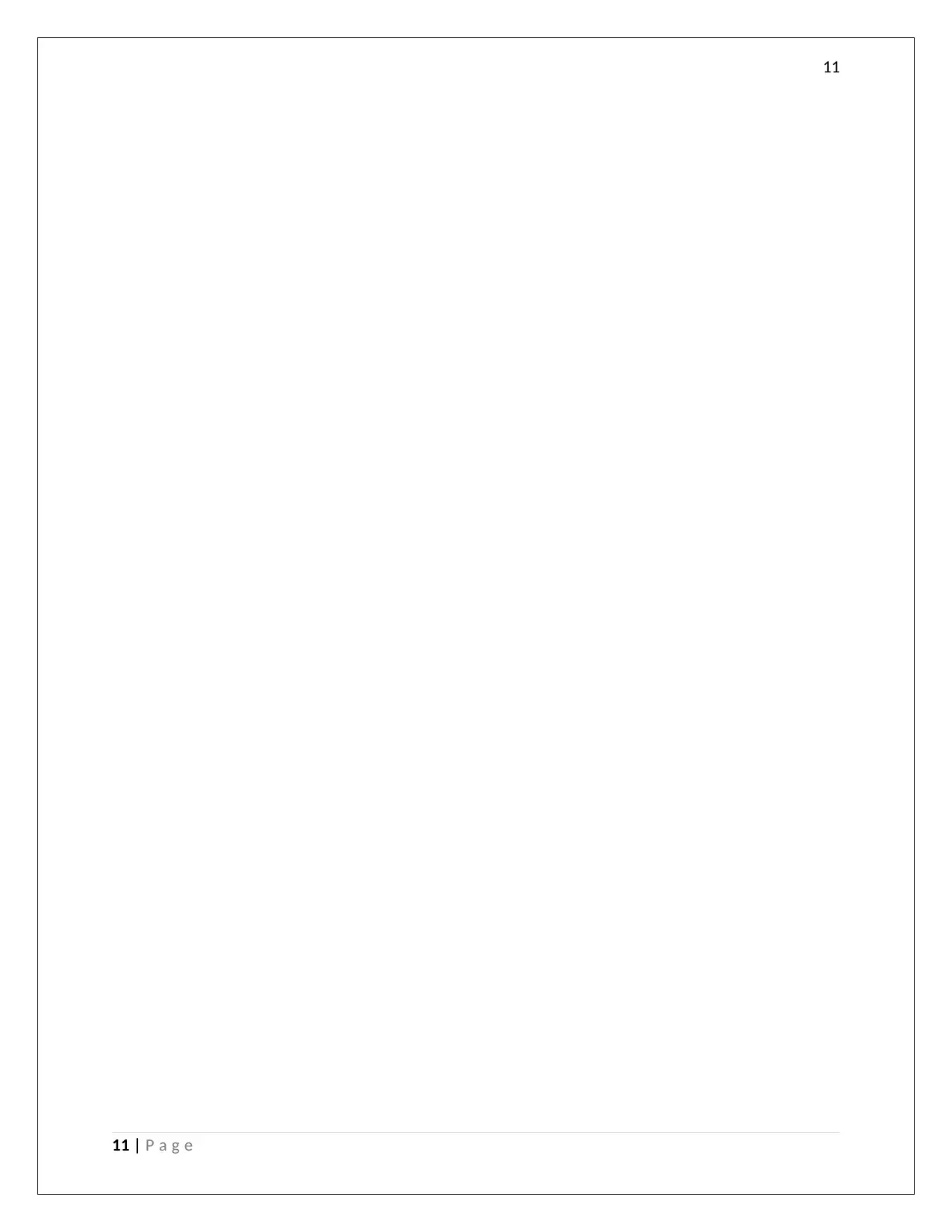
11
11 | P a g e
11 | P a g e
⊘ This is a preview!⊘
Do you want full access?
Subscribe today to unlock all pages.

Trusted by 1+ million students worldwide
1 out of 12
Related Documents
Your All-in-One AI-Powered Toolkit for Academic Success.
+13062052269
info@desklib.com
Available 24*7 on WhatsApp / Email
![[object Object]](/_next/static/media/star-bottom.7253800d.svg)
Unlock your academic potential
Copyright © 2020–2025 A2Z Services. All Rights Reserved. Developed and managed by ZUCOL.





